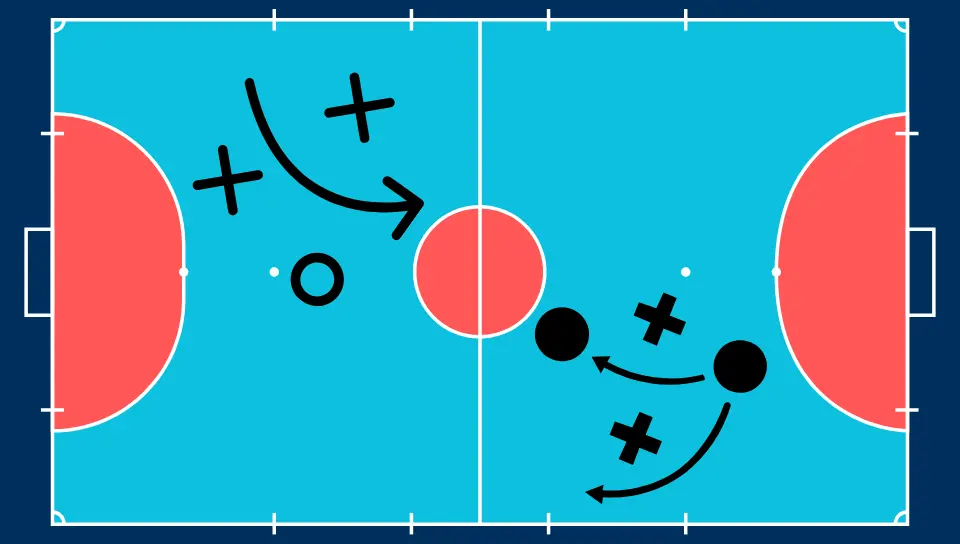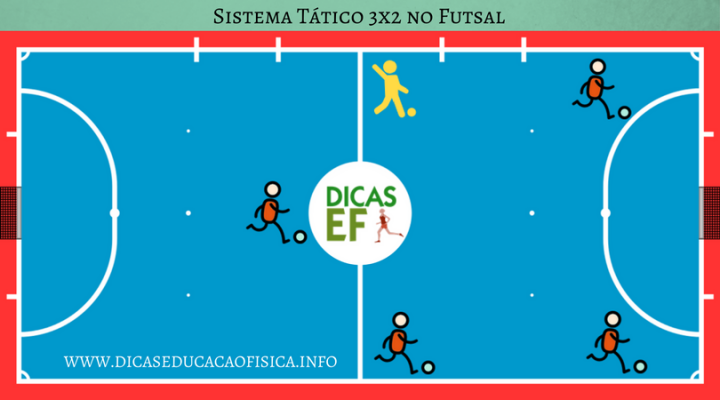Introduction: Futsal Tactics
Futsal tactics are fundamental for anyone who wants to learn how to play Futsal. Have you ever left the court thinking you lost a game you should have won – just because you lacked tactical organization?
In Futsal, tactics are extremely important and often a game is lost due to a lack of strategy, i.e. a lack of knowledge about the positions of Futsal players and Futsal’s tactical systems.
Skill x Game System
The skill of the players is fundamental to winning a Futsal match, but the difference can lie in a good system of play, in other words, in the positioning and organization strategy that a Futsal team adopts during the game. You can have a team with a bunch of skilled players playing Futsal in a disorganized way or a team with skilled players, playing Futsal in an organized way and feared by their opponents. Which do you prefer?
The Positions of Futsal Players
The Fixed
The center back is the most defensive player in a Futsal team. The characteristics of a good center back are that he is a good marker and has a good pass. They must also be communicative in order to organize their team’s marking and passing.
The Wings
In Futsal, there are right wingers and left wingers. The wingers are the players who occupy the sides of the court. The characteristics of wingers are speed and agility, both in attacking and defending.
The Pivot
The Pivot is the most advanced or offensive player in a Futsal team. The characteristics of a good Pivot are good ball control, a good pass and a good shot/finish. The Pivot usually receives the ball with his back to the opposing goalkeeper, from which point the Pivot can pass the ball to a teammate who is approaching or try to turn and finish by shooting at goal. The Pivot must be constantly on the move, looking for spaces in the opposing defense to receive the ball.
The Goalkeeper
The goalkeeper is the player whose main objective is to prevent the ball from entering his own goal. The goalkeeper must be fast and can use any part of his body to make a save. A good goalkeeper must be agile, have good positioning and communicate a lot with his teammates to organize the defensive system.
The Goalkeeper Line
The Line Goalkeeper is the goalkeeper who takes on the role of line player when his team has possession of the ball. This usually happens when a team is losing a match and needs to increase its attacking options in order to reverse the result. The Line Goalkeeper can be the goalkeeper himself who plays as a line player or a line player who replaces the goalkeeper.
” Any questions about positions in Futsal? Leave a comment and we’ll get back to you.”
Futsal’s Tactical Systems
There are different forms of Futsal tactics, both defensive and offensive systems. In other words, a tactical system or tactical scheme is the way a Futsal team positions itself on the court.
How to choose a tactical system?
The choice of playing system for a Futsal team must be based on the characteristics of the players who make up the team. If you’re a Futsal coach, don’t try to impose a tactical scheme on your team without taking into account the characteristics of your players.
The best tactical formation depends on a number of factors:
- who are you playing against?
- What are the characteristics of the players in your team?
- What is the fitness level of your team’s players?
“The best way to apply any tactical system is to keep in mind your basic defensive formation, which means that when your team is without possession of the ball, that’s the organizational pattern the players should follow on the court.”
Understand! When the team is attacking, Futsal tactics are also important, but because there is a lot of movement to occupy space, there shouldn’t be a rigid positioning of the players in attack.
Below is an analysis of the advantages and disadvantages of the main tactical systems in Futsal.
Futsal Tactics: 2×2 or Square System
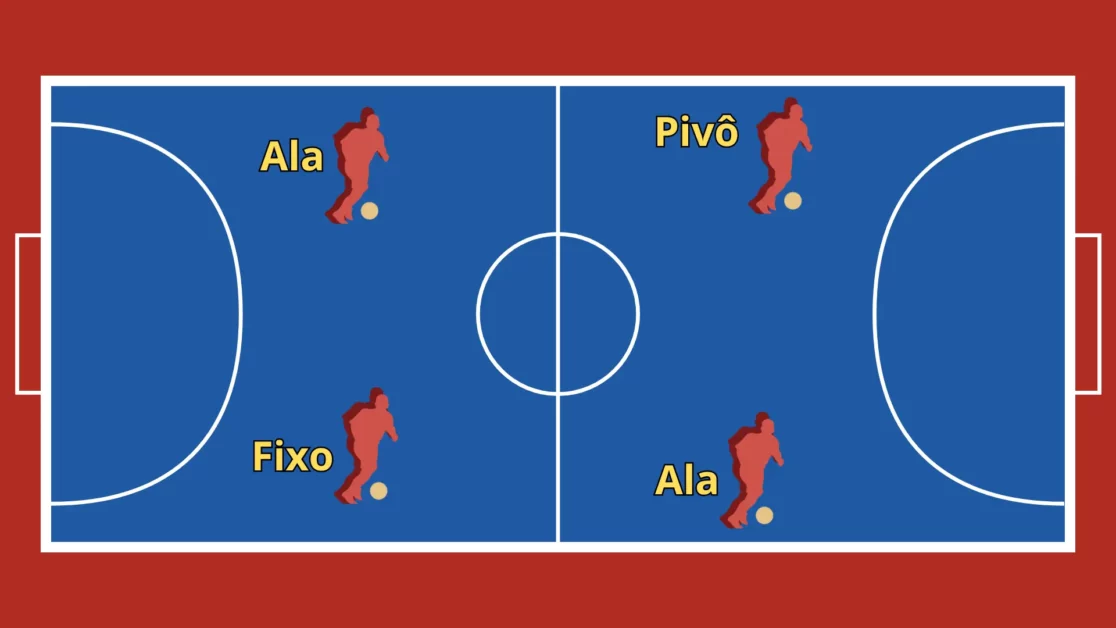
The 2×2 Tactical System in Futsal, also known as the “Square”, basically divides a team’s four line players into their two main areas of responsibility: defense and attack. It is a simple system that can help develop good pairs of defenders and attackers.
Although two players are told to become more advanced (in attack) and two to get more indented (in defence), these roles will need to be quite flexible, as the attackers will need to help the defense and vice versa. In addition most teams attack and defend with at least three players.
Advantages of the 2×2 System in Futsal
- Great system for beginners
- It strikes balance between attack and defense.
- It ensures that the defense and attack have at least one player at all times in the game.
Disadvantages of the 2×2 System in Futsal
- Restricts player movement
- It can be defensively weak if defenders join the attack and the attackers are unwilling to perform defensive duties
- Whether the team is untrained or not communicating well on the court there may be confusion between which of the attackers should support the defense and between which defender should support the attack.
2x1x1 system in Futsal
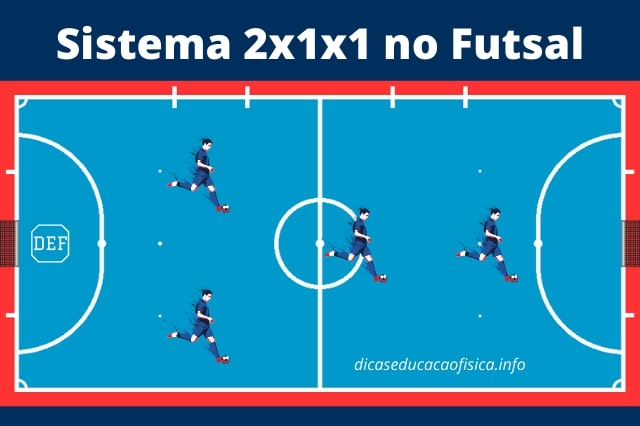
The 2x1x1 system in Futsal is a variation of the 2×2 system.
- It’s also simple and easy to learn.
- It has two players dedicated to defense.
- It has a midfielder to give more defensive balance and attacking variation.
Futsal Tactics: 3×1 or Diamond System
This is one of the most common formations in Futsal, providing a balance between defence and attack. It has a player dedicated to attack (the Pivot), while there is also a player dedicated to the defense (the Fixed). There are also two Wards, the Right Wing and the Left Wing who must support both the defense and the attack.
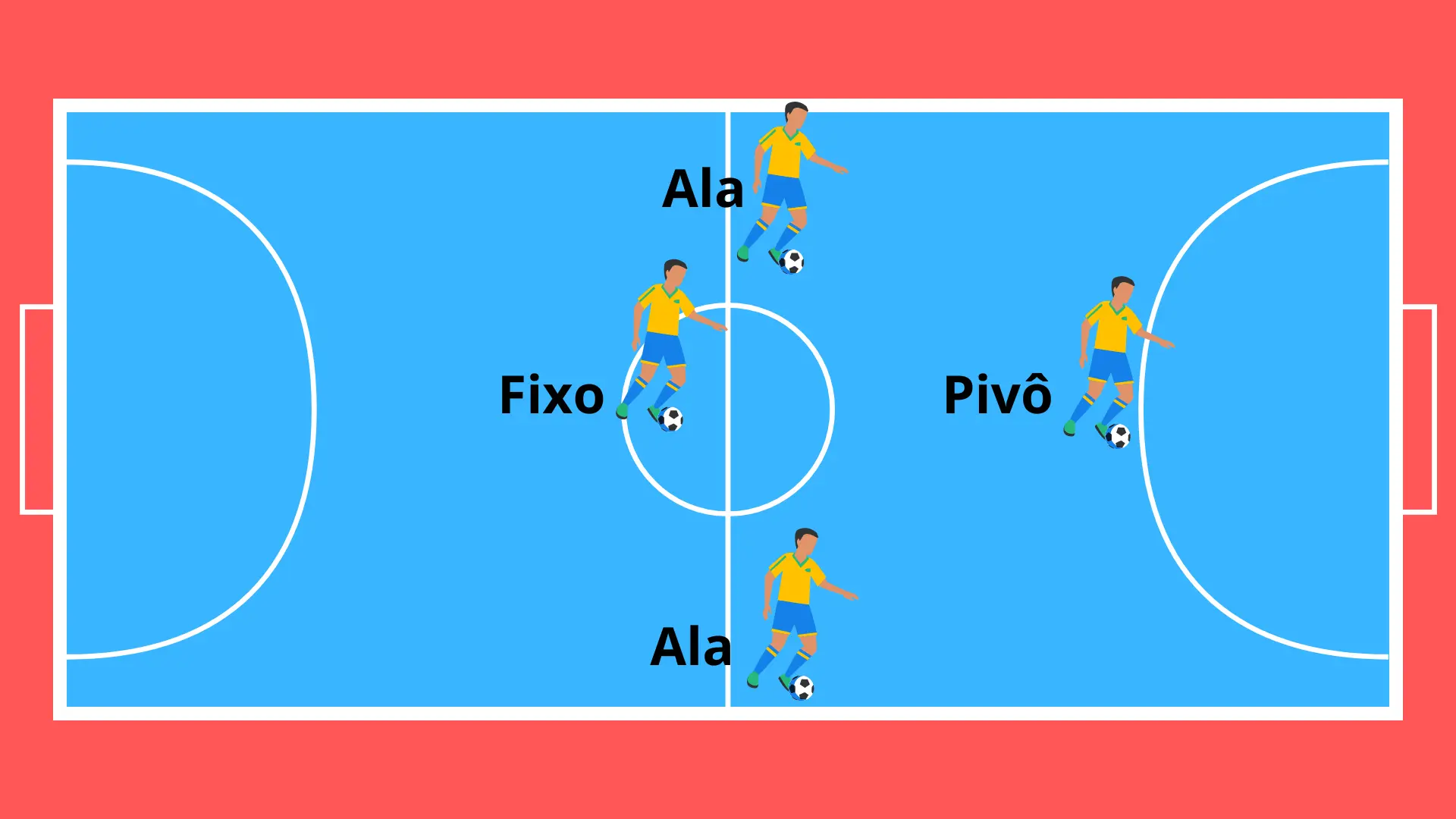
Advantages of the 3×1 System:
- There is clearly a player with the leading defense specialist and an attacking specialist player
- The team gets more compact both to defend and to attack
Disadvantages of the 3×1 System
- If both wards focus too much on the attack it will leave the defense too exposed and Fixed overloaded
- You can also overload the Pivot if the Wards have offensive difficulties
1×3 system in Futsal
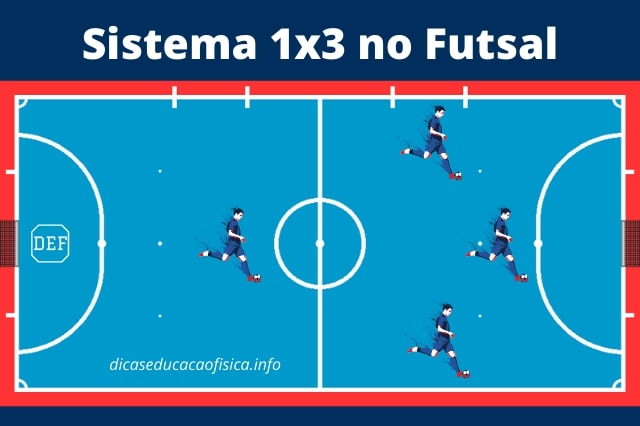
The 1×3 system in Futsal is a more offensive variation of the 3×1 system.
- It’s extremely offensive.
- It requires a high line of marking, with pressure on the opposition’s ball.
- It requires a lot of physical intensity and attacking movement.
- They only have one fixed player in defense and therefore become fragile defensively.
Futsal tactics: 4×0 system
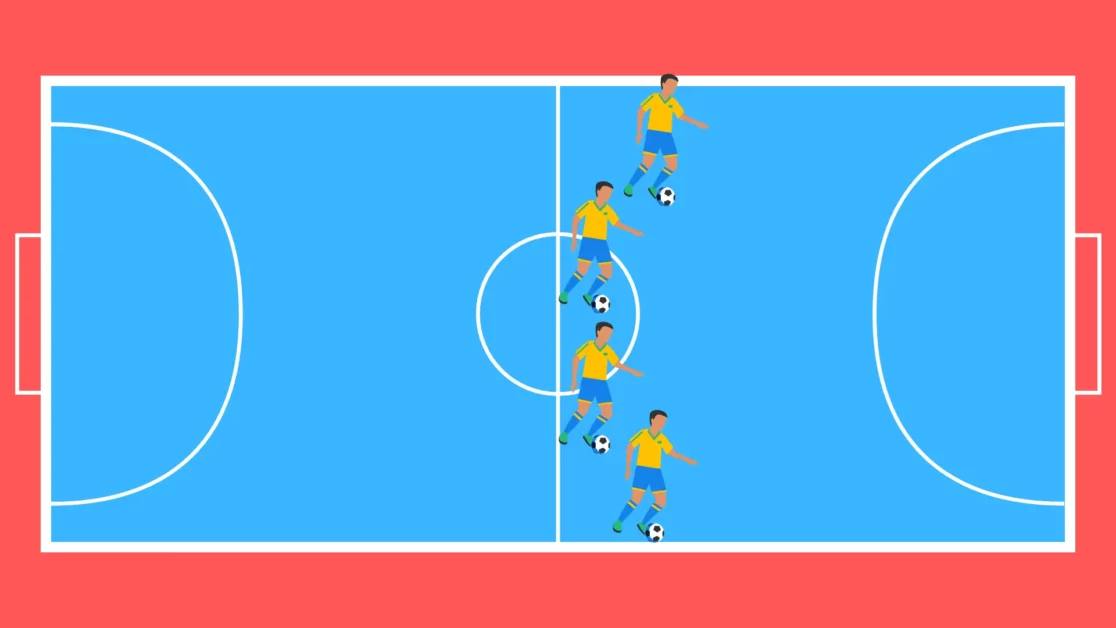
The 4×0 tactical system in Futsal is used by high-level teams, such as professional teams. The idea is to have all 4 players moving at once, promoting a move that allows many table options, space occupancy and attack opportunities.
Advantages of the 4×0 System in Futsal
- Promotes more dynamic team drive
- Always allows table options
- Makes it difficult to defend the opposing team due to great movement
- Physically can wear the defending team
- The ball moves extremely fast
- Great option to maintain possession of the ball
- Facilitates space occupancy
- Best way out of pressure marking
- Makes it difficult to cover the opposing team
Disadvantages of the 4×0 System
- Everyone on the court MUST understand the system otherwise it will not work!
- Players must be extremely well conditioned physically
- If players focus too much on moving the team gets predictable and unoffensive
- Players MUST be technically good
- Players MUST be agile
- Generates a lot of physical wear
0x4 system in Futsal
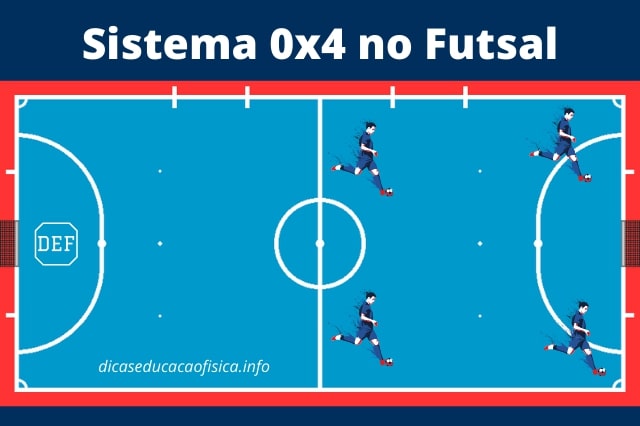
It’s a more attacking variation on the 4×0 system.
- There is pressure marking.
- It requires intensity and physical strength.
- Used at the end of the game when the team needs to overturn the score.
- There isn’t much in the way of playmaking, it depends on the goalkeeper’s throw-ins.
- It’s fragile defensively. It leaves too many gaps for the opposing team to counter-attack.
Futsal tactics: 3×2 system
The 3×2 Tactical System in Futsal takes place when the goalkeeper (Goalkeeper Line) leaves his area to take part in his team’s attacking moves. Usually the goalkeeper is replaced by a line player, to make this system more offensively efficient. With this training players do not change positions often. They try to tire the defenders by passing the ball quickly in every corner of the court.
DETAIL: In the image above, the goalkeeper (in yellow) is positioned in the attacking half of the field. This is because the Futsal rule restricts the goalkeeper’s possession of the ball in the defending half of the field, he cannot receive the ball more than once and he cannot keep it for more than 4 seconds (being in the defending half of the field).
“In this formation, it’s important for the players to be very precise with their passes and wait for a clear opportunity to shoot on goal, because a hasty shot or a wrong pass can be fatal, as the goalkeeper will be out of his depth.”
Advantages of the 3×2 System
- You create a numerical advantage when attacking
- Enables the creation of clear opportunities for submissions
Disadvantages of the 3×2 System
- There is a great risk of suffering a counterattack goal, as the goalkeeper is out of the goal in this system
- The team can play with a goalkeeper not expert in defending
2×3 System in Futsal
The 2×3 system in Futsal is an even more offensive variation of the 3×2 system in Futsal.
- It has 3 players infiltrating near or inside the opposing team’s goal area.
- It has two players setting up plays in the middle of the court.
- It is extremely vulnerable to counter-attacks and long-range shots from the opposition.
- Used at the end of the game when the team needs to overturn the score.
